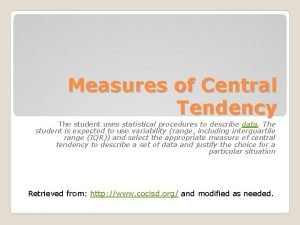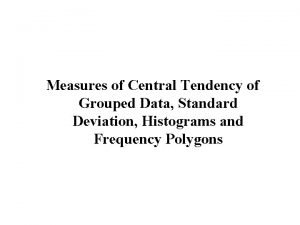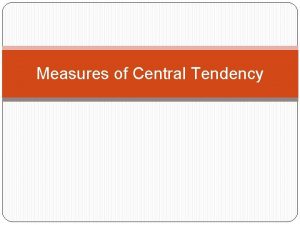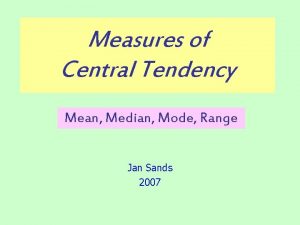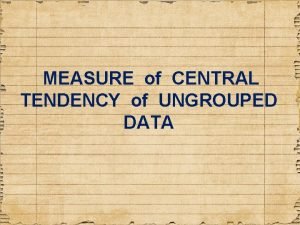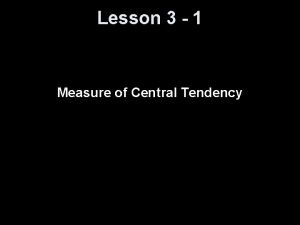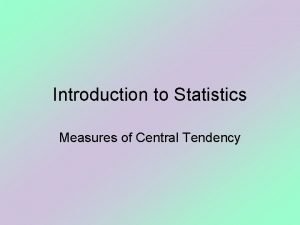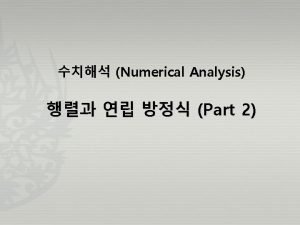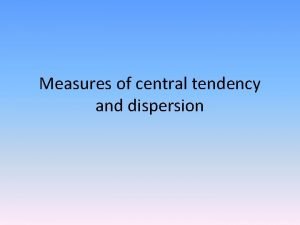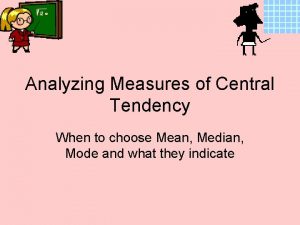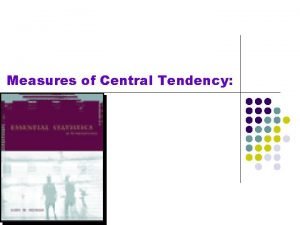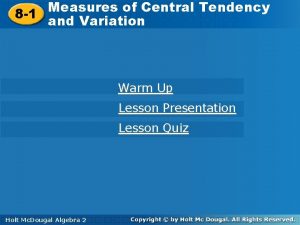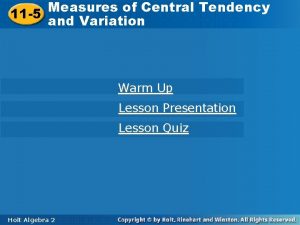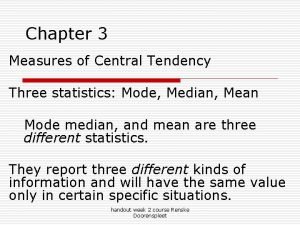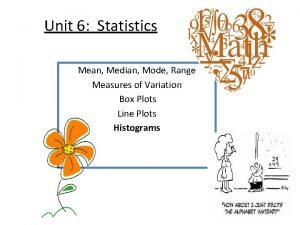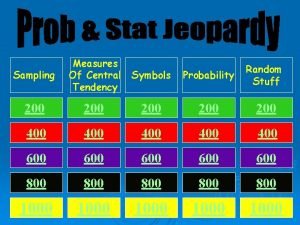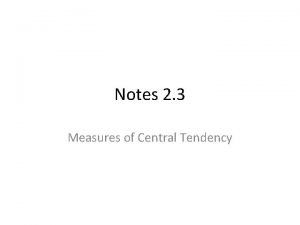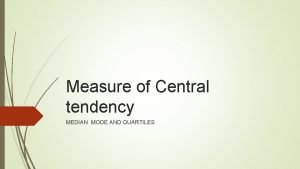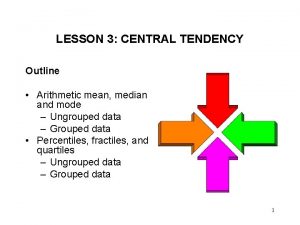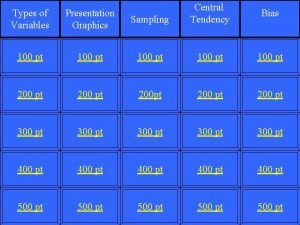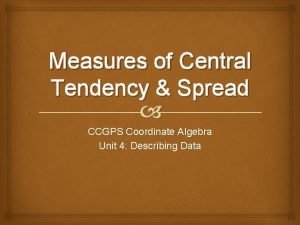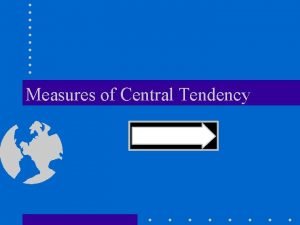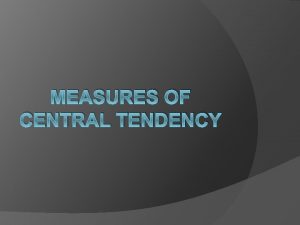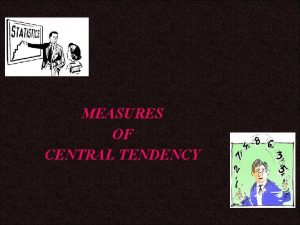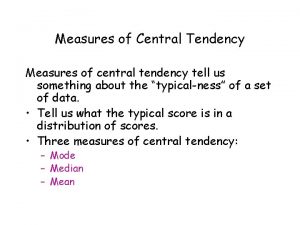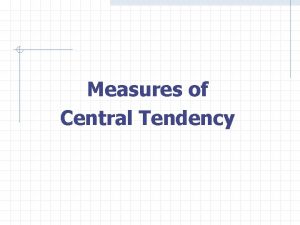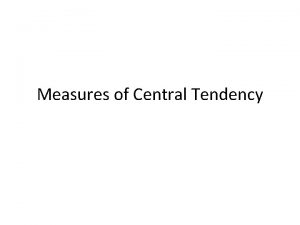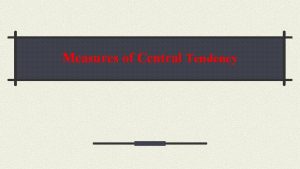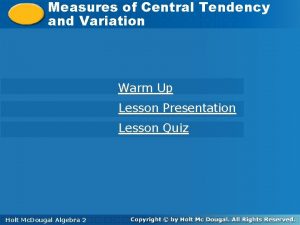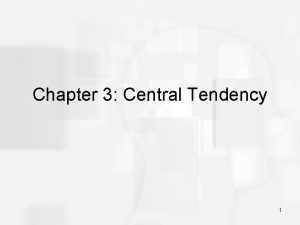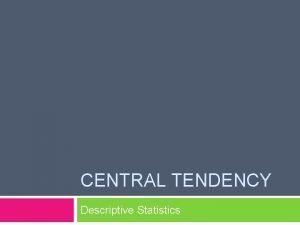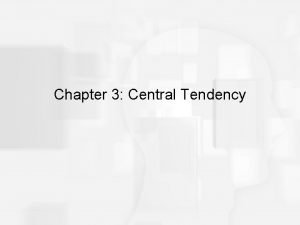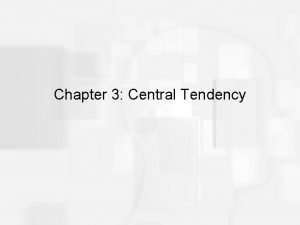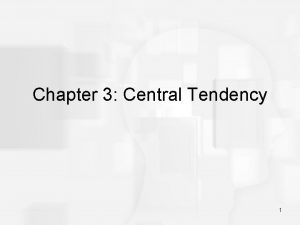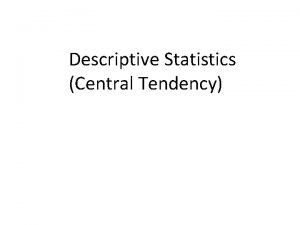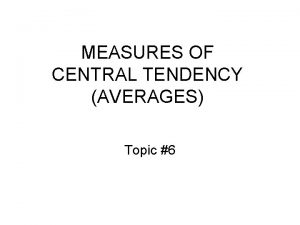Measures of Central Tendency Outline of the Course






















- Slides: 22

Measures of Central Tendency:

Outline of the Course III. Descriptive Statistics A. Measures of Central Tendency (Chapter 3) 1. Mean 2. Median 3. Mode B. Measures of Variability (Chapter 4) 1. Range 2. Mean deviation 3. Variance 4. Standard Deviation C. Skewness (Chapter 2) 1. Positive skew 2. Normal distribution 3. Negative skew D. Kurtosis 1. Platykurtic 2. Mesokurtic 3. Leptokurtic

Measures of Central Tendency l l The goal of measures of central tendency is to come up with the one single number that best describes a distribution of scores. Lets us know if the distribution of scores tends to be composed of high scores or low scores.

Measures of Central Tendency l There are three basic measures of central tendency, and choosing one over another depends on two different things. l 1. The scale of measurement used, so that a summary makes sense given the nature of the scores. l 2. The shape of the frequency distribution, so that the measure accurately summarizes the distribution.

Measures of Central Tendency Mode l The most common observation in a group of scores. l l l Distributions can be unimodal, bimodal, or multimodal. If the data is categorical (measured on the nominal scale) then only the mode can be calculated. The most frequently occurring score (mode) is Vanilla. Flavor f Vanilla 28 Chocolate 22 Strawberry 15 Neapolitan 8 Butter Pecan 12 Rocky Road 9 Fudge Ripple 6

Measures of Central Tendency Mode l The mode can also be calculated with ordinal and higher data, but it often is not appropriate. l l If other measures can be calculated, the mode would never be the first choice! 7, 7, 7, 20, 23, 24, 25, 26 has a mode of 7, but obviously it doesn’t make much sense.

Measures of Central Tendency Median l l The number that divides a distribution of scores exactly in half. l The median is the same as the 50 th percentile. Better than mode because only one score can be median and the median will usually be around where most scores fall. If data are perfectly normal, the mode is the median. The median is computed when data are ordinal scale or when they are highly skewed.

Measures of Central Tendency Median l There are three methods for computing the median, depending on the distribution of scores. l First, if you have an odd number of scores pick the middle score. l l l Second, if you have an even number of scores, take the average of the middle two. l l l 1 4 6 7 12 14 18 Median is 7 1 4 6 7 8 12 14 16 Median is (7+8)/2 = 7. 5 Third, if you have several scores with the same value in the middle of the distribution use the formula for percentiles (not found in your book).

Measures of Central Tendency Mean l The arithmetic average, computed simply by adding together all scores and dividing by the number of scores. It uses information from every single score. l For a population: l For a Sample:

Measures of Central Tendency Mean Other Notes l If data are perfectly normal, then the mean, median and mode are exactly the same. l I would prefer to use the mean whenever possible since it uses information from EVERY score. l Though the preferred symbol for the mean is an X with a line over the top, creating this symbol is pretty tricky on the computer. APA style says:

Measures of Central Tendency The Shape of Distributions l l l With perfectly bell shaped distributions, the mean, median, and mode are identical. With positively skewed data, the mode is lowest, followed by the median and mean. With negatively skewed data, the mean is lowest, followed by the median and mode.

Measures of Central Tendency Mean vs. Median Salary Example l l On one block, the income from the families are (in thousands of dollars) 40, 42, 41, 45, 38, 40, 42, 500 l SX=788, l The Mean salary for this sample is $98, 500 which is more than twice almost all of the scores. Arrange the scores 38, 40, 41, 42, 45, 500 l The middle two #’s are 41 and 42, thus the average is $41500, perhaps a more accurate measure of central tendency.

Measures of Central Tendency Mean vs. Median Reaction Time Example l Data is time to complete task (in s): l 45, 34, 87, 56, 21, didn’t finish, 49 l It is not possible to compute a mean with this unknown number. Even though we do not know this person’s time, I do know it is REALLY big. l l l 21, 34, 45, 49, 56, 87, something bigger The median is the middle number, 49

Measures of Central Tendency Mean Algebra Revisited l Its useful to consider the formula as the same as any other algebraic formulas, subject to the same rules. l Therefore, if we know the mean of a group of scores, we can figure out the SX.

Measures of Central Tendency Mean Weighted Mean l Lets pretend that one semesters class of 23 students scored M 1 = 18 points on a quiz. The same quiz was then given the next semester to 34 students who then got M 2 = 22 points. What is the overall (weighted) mean for these 57 students. l SX 1 can be computed by multiplying M 1 times the sample size (SX 1= M 1*n 1 = 18*23 = 414). l For the second class, SX 2 = M 2*n 2 = 22 * 34 = 748 l SXtotal = SX 1 + SX 2 = 414 + 748 = 1206 l ntotal = n 1 + n 2 = 23 + 34 = 57 l Mtotal = SXtotal / ntotal = 1206/57 = 21. 158

Measures of Central Tendency Mean Adding a Score l On the first exam, 15 students had M = 85. l One kid came in late and took the test and scored 53, what is Mnew? l SXoriginal = Moriginal*noriginal = 85*15 = 1275 l SXnew = SXoriginal + new score = 1275 + 53 = 1328 l nnew = noriginal + 1 l Mnew = SXnew/nnew = 1328/16 = 83

Measures of Central Tendency Mean Changing an Existing Score l On the first exam, 16 students had M = 83. l One kid came in after the test and complained, I listened and decided to give him 10 extra points, now what? l SXoriginal = Moriginal*noriginal = 83*16 = 1328 l SXnew = SXoriginal + extra points = 1328 + 10 = 1338 l Mnew = SXnew/n = 1338/16 = 83. 625

Measures of Central Tendency Mean Transformations l l If a constant is added (or subtracted) to each score, the same constant will be added (or subtracted) to the mean. l If M for an exam is 82, then I find that I screwed up a question and give everyone 5 extra points, M simply becomes 82+5=87. If every score is multiplied or divided by a constant number, then the mean will also be multiplied or divided by the same number. l This last property is particularly useful when converting between units of measurement. l If the M for the height of a group of first-graders is 47 inches, but I need to know their heights in cm I could: l Take every kids height * 2. 54, then recompute M l Or, I could take the mean times 2. 54 and conclude the M height of these kids is 119. 38 cm.

Measures of Central Tendency Deviations around the Mean l A common formula we will be working with extensively is the deviation: SX = 72 n=8 Exam Score 7 (7 -9) = -2 6 8 9 12 10 11 9 (6 -9) = -3 (8 -9) = -1 (9 -9) = 0 (12 -9) = 3 (10 -9) = 1 (11 -9) = 2 (9 -9) = 0

Measures of Central Tendency Using the Mean to Interpret Data Predicting Scores l l l If asked to predict a score, and you know nothing else, then predict the mean. However, we will probably be wrong, and our error will equal: A score’s deviation indicates the amount of error we have when using the mean to predict an individual score.

Measures of Central Tendency Using the Mean to Interpret Data Describing a Score’s Location l If you take a test and get a score of 45, the 45 means nothing in and of itself. However, if you learn that the M = 50, then we know more. Your score was 5 units BELOW M. l Positive deviations are above M. l Negatives deviations are below M. l Large deviations indicate a score far from M. l Large deviations occur less frequently.

Measures of Central Tendency Using the Mean to Interpret Data Describing the Population Mean l l Remember, we usually want to know population parameters, but populations are too large. So, we use the sample mean to estimate the population mean.
 Measures of central tendency
Measures of central tendency Grouped data measures of central tendency
Grouped data measures of central tendency Objectives of measures of central tendency
Objectives of measures of central tendency Range in central tendency
Range in central tendency Central tendency symbols
Central tendency symbols Objectives of central tendency
Objectives of central tendency Measures of central tendency
Measures of central tendency Variance formula for grouped data
Variance formula for grouped data Nxn 역행렬 알고리즘
Nxn 역행렬 알고리즘 Central tendency and dispersion
Central tendency and dispersion Choosing the best measure of central tendency worksheets
Choosing the best measure of central tendency worksheets Central tendency symbols
Central tendency symbols Lower boundary of modal class
Lower boundary of modal class Central tendency symbols
Central tendency symbols Measures of central tendency and variation
Measures of central tendency and variation Statistics chapter 3 measures of central tendency
Statistics chapter 3 measures of central tendency Unit 6 review #2 - measures of central tendency
Unit 6 review #2 - measures of central tendency Measures of central tendency symbols
Measures of central tendency symbols Measures of central tendency notes
Measures of central tendency notes Measure of central tendency
Measure of central tendency Formula of mean
Formula of mean Central tendency bias
Central tendency bias Central tendency and spread homework
Central tendency and spread homework
